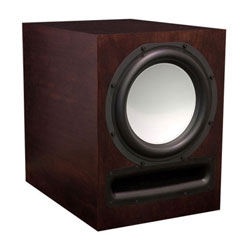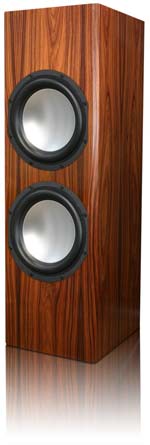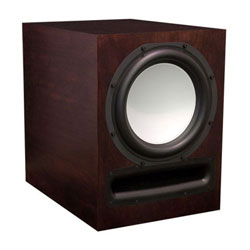During my adolescence, it was Frankie Lymon and the Teenagers who had a big pop hit with "The ABCs of Love". While I'm no expert on that subject, you may find some of my ABCs of Bass helpful in getting more of the rhythmic drive from your sound system that provides "the beat" for most pop and rock music.
A is for Area
Other things being equal (and there are many trade-offs that a designer may consider), the larger the woofer or woofers' cones' area and the larger the enclosure (those two have to be combined) the greater the potential for more output and deeper bass. (That's why very small speakers need subwoofer assistance to reproduce convincing powerful bass.)
B is for Box

EP500 Powered subwoofer in Cherry Wood, Chestnut Stain, Satin Finish.
It's possible to get deep bass from a small subwoofer enclosure, but the designer usually sacrifices efficiency and maximum loudness capability. The smaller sub with its typically smaller driver has to "work" harder to excavate frequencies, so it will also need a powerful amplifier, and because the small driver moves in and out over a greater distance (excursion) to generate the pressure waves, it won't play as loud as a sub that uses a big box and larger-diameter driver. For example, Axiom's EP400 sub uses a compact cabinet with a smaller 8-inch dual-voice-coil driver powered by a 500-watt amplifier to produce ultra-low frequencies to 20 Hz. But it's better suited to smaller rooms and it won't play as loud in big rooms as its bigger EP500 brother, with its 12-inch diameter driver and larger cabinet.
C is for Corner
Corner locations of subwoofers and floorstanding speakers will produce powerful bass but often it isn't all that smooth. One or two notes may stand out, sounding bloated, like the old days of pounding disco "one-note" bass. A better location is part way along a side or rear wall. As you move a subwoofer away from a corner, deep bass becomes more even with less of a tendency to get "boomy".
D is for Class D
Almost all subwoofer amplifiers nowadays are class D switching designs because they run cooler, are more efficient and use less power, and are typically lighter and physically smaller than older analog amps.
E is for Enemy

EP800 Powered subwoofer in Rosewood, Natural Stain, High Gloss Finish.
The enemy of powerful deep bass is poor placement of the subwoofer and/or your listening seat. Don't put your couch in the center of a room because often that is where there's a "null" or cancellation of bass. Sitting about 60% to 80% back from the front wall is about right. Avoid placing the couch against a rear wall. Typically that produces unnatural bass boost, a sort of hot spot like a corner location.
F is for Frequency
If you don't like the quality or quantity of bass you are getting, then move the subwoofer to a different location. Swap places with the subwoofer and your listening area, putting the sub where you normally sit. Crawl around the room while playing music with deep bass and the spot where the bass is smoothest and best is where you should move the subwoofer. And speaking of frequency, more subwoofers are always better than a single one. The goal is to get deep, smooth and even bass at all listening locations and there is no better means to that end than adding a second subwoofer. Placing a second sub at opposite ends or opposite sides of the room will result in much smoother and better bass for all viewers and listening location






